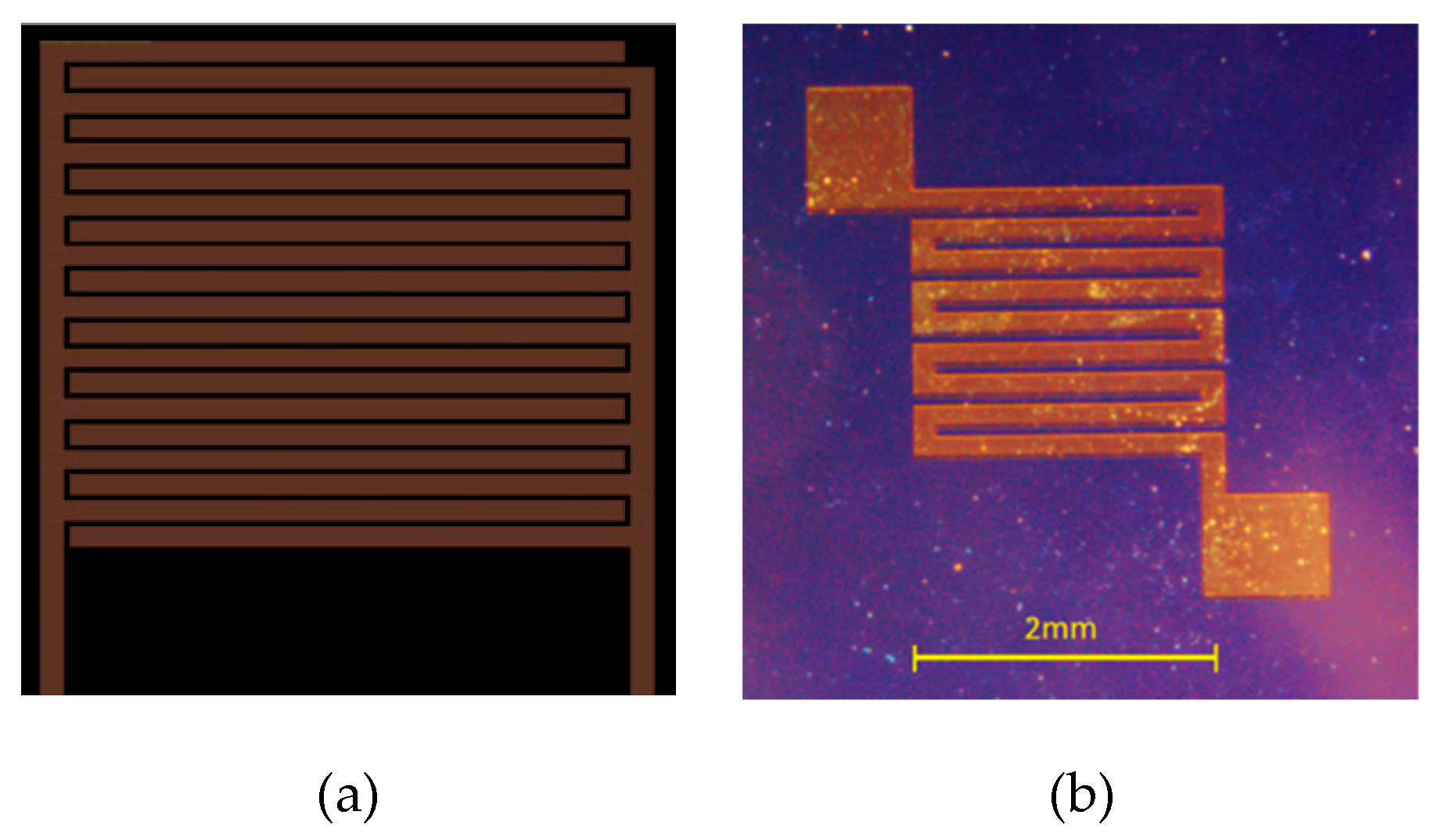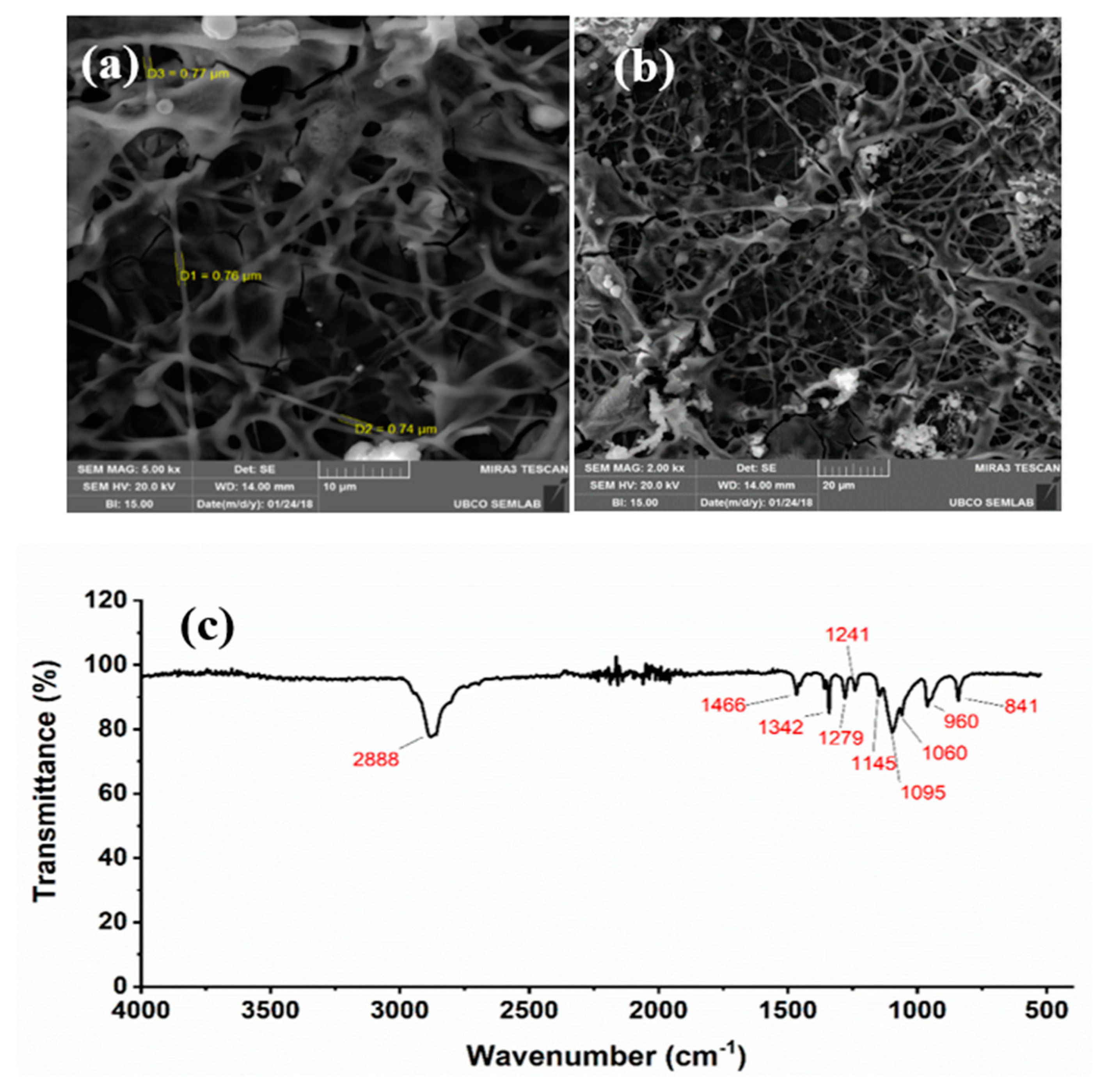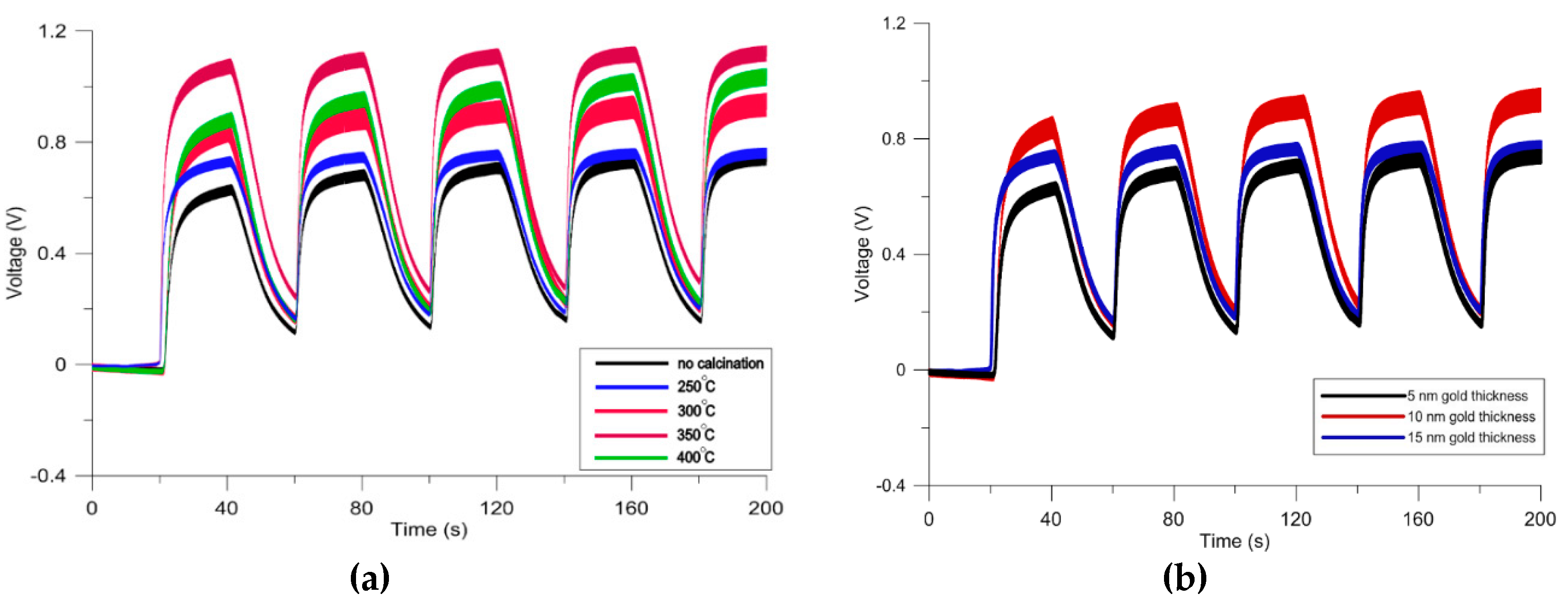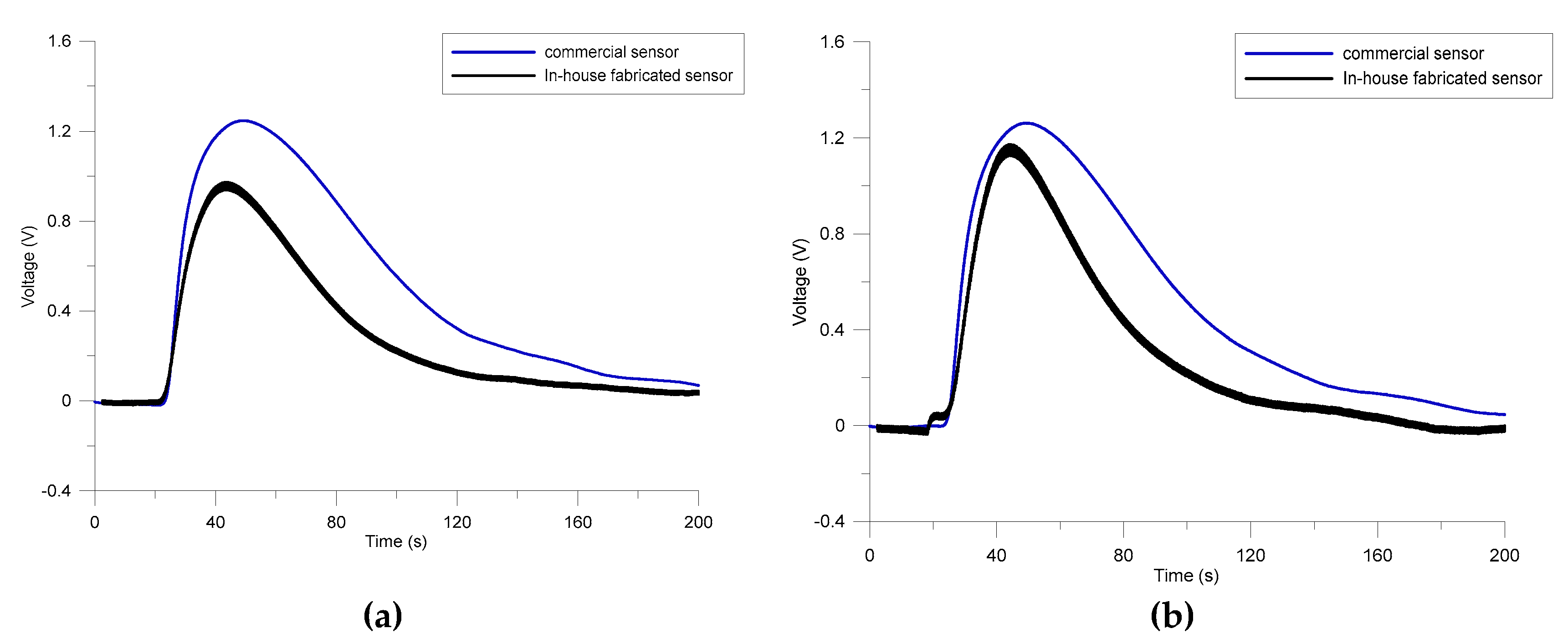Fabrication of SnO2 Composite Nanofiber-Based Gas Sensor Using the Electrospinning Method for Tetrahydrocannabinol (THC) Detection
Abstract
:1. Introduction
2. Materials and Methods
3. Results
3.1. Sensor Characterization
3.2. Sensor Response to THC
4. Conclusions
Supplementary Materials
Author Contributions
Funding
Conflicts of Interest
References
- Gas Sensors Market by Gas Type Technology, End-Use Application, Geography—Global Forecast 2023. Available online: https://www.marketwatch.com/press-release/gas-sensors-market-by-gas-type-technology-end-use-application-geography---global-forecast-2023-2017-08-07 (accessed on 11 February 2020).
- Gouma, P.-I.; Wang, L.; Simon, S.R.; Stanacevic, M. Novel Isoprene Sensor for a Flu Virus Breath Monitor. Sensors 2017, 17, 199. [Google Scholar] [CrossRef] [PubMed] [Green Version]
- Sakumura, Y.; Koyama, Y.; Tokutake, H.; Hida, T.; Sato, K.; Itoh, T.; Akamatsu, T.; Shin, W. Diagnosis by Volatile Organic Compounds in Exhaled Breath from Lung Cancer Patients Using Support Vector Machine Algorithm. Sensors 2017, 17, 287. [Google Scholar] [CrossRef] [PubMed] [Green Version]
- Sethi, S.; Nanda, R.; Chakraborty, T. Clinical Application of Volatile Organic Compound Analysis for Detecting Infectious Diseases. Clin. Microbiol. Rev. 2013, 26, 462–475. [Google Scholar] [CrossRef] [PubMed] [Green Version]
- Schivo, M.; Aksenov, A.A.; Linderholm, A.L.; McCartney, M.M.; Simmons, J.; Harper, R.W.; Davis, C.E. Volatile emanations from in vitro airway cells infected with human rhinovirus. J. Breath Res. 2014, 8, 037110. [Google Scholar] [CrossRef] [PubMed] [Green Version]
- World Health Organization (WHO). Guide to Cancer Early Diagnosis. 2017. Available online: https://www.who.int/cancer/publications/cancer_early_diagnosis/en/ (accessed on 11 February 2020).
- Wilson, A.D. Diverse Applications of Electronic-Nose Technologies in Agriculture and Forestry. Sensors 2013, 13, 2295–2348. [Google Scholar] [CrossRef] [Green Version]
- Mallin, D. Increasing the Selectivity and Sensitivity of Gas Sensors for the Detection of Explosives. Master’s Thesis, University of Rhode Island, Kingston, RI, USA, 2014. [Google Scholar]
- Environment and Climate Change Canada, Canadian Environmental Sustainability Indicators. Air Pollutant Emissions. Available online: https://www.canada.ca/en/environment-climate-change/services/environmental-indicators/air-pollutant-emissions.html (accessed on 11 February 2020).
- National Research Council (US) Committee on Toxicology. ARSINE. In Emergency and Continuous Exposure Limits for Selected Airborne Contaminants; National Academy Press: Washington, DC, USA, 1984. [Google Scholar]
- Das, S.; Pal, S.; Mitra, M. Significance of Exhaled Breath Test in Clinical Diagnosis: A Special Focus on the Detection of Diabetes Mellitus. J. Med Boil. Eng. 2016, 36, 605–624. [Google Scholar] [CrossRef] [Green Version]
- Mirzaei, H.; O’Brien, A.; Tasnim, N.; Ravishankara, A.; Tahmooressi, H.; Hoorfar, M. Topical review on monitoring tetrahydrocannabinol in breath. J. Breath Res. 2019. [Google Scholar] [CrossRef]
- Ionescu, R. Low-level detection of ethanol and H2S with temperature-modulated WO3 nanoparticle gas sensors. Sensors Actuators B Chem. 2005, 104, 132–139. [Google Scholar] [CrossRef]
- Du, H.; Wang, J.; Su, M.; Yao, P.; Zheng, Y.; Yu, N. Formaldehyde gas sensor based on SnO2/In2O3hetero-nanofibers by a modified double jets electrospinning process. Sens. Actuators B Chem. 2012, 166, 746–752. [Google Scholar] [CrossRef]
- Wang, D.; Zhang, M.; Chen, Z.; Li, H.; Chen, A.; Wang, X.; Yang, J. Enhanced formaldehyde sensing properties of hollow SnO2 nanofibers by graphene oxide. Sens. Actuators B Chem. 2017, 250, 533–542. [Google Scholar] [CrossRef]
- Wang, L.; Kang, Y.; Liu, X.; Zhang, S.; Huang, W.; Wang, S. ZnO nanorod gas sensor for ethanol detection. Sens. Actuators B Chem. 2012, 162, 237–243. [Google Scholar] [CrossRef]
- Lee, Y.; Huang, H.; Tan, O.; Tse, M. Semiconductor gas sensor based on Pd-doped SnO2 nanorod thin films. Sens. Actuators B Chem. 2008, 132, 239–242. [Google Scholar] [CrossRef]
- Tan, W.; Tan, J.; Fan, L.; Yu, Z.; Qian, J.; Huang, X. Fe2O3-loaded NiO nanosheets for fast response/recovery and high response gas sensor. Sens. Actuators B Chem. 2018, 256, 282–293. [Google Scholar] [CrossRef]
- Zhu, Y.; Wang, Y.; Duan, G.; Zhang, H.; Li, Y.; Liu, G.; Xu, L.; Cai, W. In situ growth of porous ZnO nanosheet-built network film as high-performance gas sensor. Sens. Actuators B Chem. 2015, 221, 350–356. [Google Scholar] [CrossRef]
- Barsan, N.; Schweizer-Berberich, M.; Göpel, W. Fundamental and practical aspects un the design of nanoscaled SnO2 gas sensors: A status report. Fresenius’ J. Anal. Chem. 1999, 365, 287–304. [Google Scholar] [CrossRef]
- Nagirnyak, S.; Dontsova, T. Effect of Modification/Doping on Gas Sensing Properties of SnO2. Nano Res. Appl. 2017, 3, 1–5. [Google Scholar] [CrossRef]
- Kim, H.-J.; Lee, J.-H. Highly sensitive and selective gas sensors using p-type oxide semiconductors: Overview. Sens. Actuators B Chem. 2014, 192, 607–627. [Google Scholar] [CrossRef]
- Xiang, Q.; Meng, G.; Zhang, Y.; Xu, J.; Xu, P.; Pan, Q.; Yu, W. Ag nanoparticle embedded-ZnO nanorods synthesized via a photochemical method and its gas-sensing properties. Sens. Actuators B Chem. 2010, 143, 635–640. [Google Scholar] [CrossRef]
- Yamazoe, N.; Sakai, G.; Shimanoe, K. Oxide Semiconductor Gas Sensors. Catal. Surv. Asia 2003, 7, 63–75. [Google Scholar] [CrossRef]
- Moon, J.; Park, J.-A.; Lee, S.-J.; Zyung, T.; Kim, I.-D. Pd-doped TiO2 nanofiber networks for gas sensor applications. Sens. Actuators B Chem. 2010, 149, 301–305. [Google Scholar] [CrossRef]
- Ge, C.; Xie, C.; Cai, S. Preparation and gas-sensing properties of Ce-doped ZnO thin-film sensors by dip-coating. Mater. Sci. Eng. B 2007, 137, 53–58. [Google Scholar] [CrossRef]
- Ivanov, P.; Llobet, E.; Vilanova, X.; Brezmes, J.; Hubalek, J.; Correig, X. Development of high sensitivity ethanol gas sensors based on Pt-doped SnO2 surfaces. Sens. Actuators B Chem. 2004, 99, 201–206. [Google Scholar] [CrossRef]
- Paknahad, M.; Bachhal, J.S.; Ahmadi, A.; Hoorfar, M. Highly selective multi-target 3D-printed microfluidic-based breath analyzer. In Proceedings of the 2016 IEEE 29th International Conference on Micro Electro Mechanical Systems (MEMS), Shanghai, China, 24–28 January 2016; Institute of Electrical and Electronics Engineers (IEEE): Piscataway, NJ, USA, 2016; pp. 905–908. [Google Scholar]





© 2020 by the authors. Licensee MDPI, Basel, Switzerland. This article is an open access article distributed under the terms and conditions of the Creative Commons Attribution (CC BY) license (http://creativecommons.org/licenses/by/4.0/).
Share and Cite
Mehrabi, P.; Hui, J.; Janfaza, S.; O’Brien, A.; Tasnim, N.; Najjaran, H.; Hoorfar, M. Fabrication of SnO2 Composite Nanofiber-Based Gas Sensor Using the Electrospinning Method for Tetrahydrocannabinol (THC) Detection. Micromachines 2020, 11, 190. https://doi.org/10.3390/mi11020190
Mehrabi P, Hui J, Janfaza S, O’Brien A, Tasnim N, Najjaran H, Hoorfar M. Fabrication of SnO2 Composite Nanofiber-Based Gas Sensor Using the Electrospinning Method for Tetrahydrocannabinol (THC) Detection. Micromachines. 2020; 11(2):190. https://doi.org/10.3390/mi11020190
Chicago/Turabian StyleMehrabi, Pouria, Justin Hui, Sajjad Janfaza, Allen O’Brien, Nishat Tasnim, Homayoun Najjaran, and Mina Hoorfar. 2020. "Fabrication of SnO2 Composite Nanofiber-Based Gas Sensor Using the Electrospinning Method for Tetrahydrocannabinol (THC) Detection" Micromachines 11, no. 2: 190. https://doi.org/10.3390/mi11020190
APA StyleMehrabi, P., Hui, J., Janfaza, S., O’Brien, A., Tasnim, N., Najjaran, H., & Hoorfar, M. (2020). Fabrication of SnO2 Composite Nanofiber-Based Gas Sensor Using the Electrospinning Method for Tetrahydrocannabinol (THC) Detection. Micromachines, 11(2), 190. https://doi.org/10.3390/mi11020190







